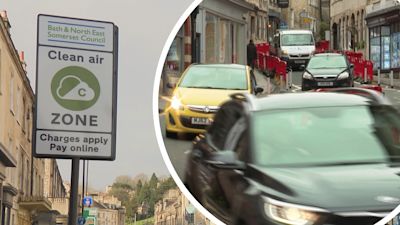Air quality in Bath improves following introduction of clean air zone

Air quality in Bath has improved since the introduction of the clean air zone in 2021, according to a new study.
Councillors have said the research's findings are 'heartening' but that there is still 'much more to do to drive down pollution' in the city.
Analysis published by Bath & North East Somerset Council reveals there has been a 26% drop in the annual mean nitrogen dioxide levels within the Clean Air Zone (CAZ) between 2019 and 2022. This represents an average reduction of 8.5 micrograms per cubic metre (μg/m3).
In urban areas outside of the zone, the study found there has been a slightly larger drop in annual mean NO2 concentrations, with a fall of 27%.
It also found there are now nine fewer sites exceeding the legal limit of 40 μg/m3 falling from 10 sites in 2019 to one site in 2022.
The 2022 Annual CAZ Report also indicated an additional reduction of 6% in annual mean NO2 concentrations in 2022 compared to the previous years 2021, and a reduction of 7% within the CAZ boundary.
BANES: 'Air pollution is a significant risk to people's health'
Councillor Sarah Warren, deputy Leader and cabinet member for Climate Emergency and Sustainable Travel, said: “It’s heartening to see the clear indications in this report that the clean air zone is working to improve air quality across the area, not just within the zone.
“Air pollution is a significant risk to people’s health, which is why the Government directed us to implement the CAZ."
But the study also highlighted that other factors, such as the partial closure of Cleveland Bridge between October 2021 to October 2022, and the impact of COVID-19, may have had a role in potentially improving air quality and reducing traffic.
Cllr Warren added: “The partial closure of Cleveland Bridge and the impact of the Covid-pandemic on traffic flow means that we cannot draw clear conclusions on the impact of the zone on traffic displacement in 2022, however, we await the government’s review of our data to confirm whether the CAZ has achieved success."
The report did find compliance with the CAZ among drivers has improved.
71% fewer polluting vehicles drove through the zone by the end of 2022 compared to when the CAZ was introduced in March 2021. This represents a fall from an average of 1,742 vehicles a day during the first week of the scheme to an average of 497 vehicles per day.
Cllr Warren said: “The upturn in compliance demonstrates support from the public which should be applauded, but we recognise that there is still more to do to drive down pollution at all locations in Bath.
"Looking ahead, we’ll pay particular attention to sites that continue to exceed legal limits and find specific solutions to combat this.
"We will also continue to promote sustainable travel alternatives to the car which will increasingly enable people to walk, cycle or wheel for healthier short journeys around the city, reducing both pollution and carbon emissions from transport.”
But the CAZ has proved controversial with some Bath residents and workers, being the first clean air zone to be introduced outside of London.
The council charges commercial drivers of the most polluting vehicles such as lorries, coaches and busses £100 a day, while those behind the wheel of non-compliant taxis, minibuses and vans are charged £9 a day.
This was recently extended to include those with a blue badge, so disabled drivers will now also be fined for using a non-compliant vehicle for commercial purposes within the zone.
Shortly after the scheme was introduced, councillors opposed to the CAZ were furious due to polluting lorries driving through towns and villages in Wiltshire to avoid paying the charges.
But Bath and North East Somerset Council says there is support for those driving non-compliant vehicles, with £9.4m in financial assistance to help people upgrade their vehicles to cleaner, compliant ones.
So far, more than 1,500 owners have applied for support, with 938 polluting vehicles replaced or upgraded by the end of 2022.